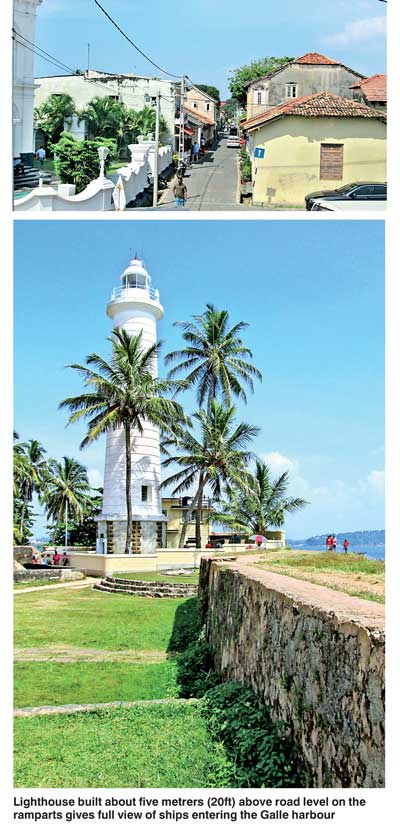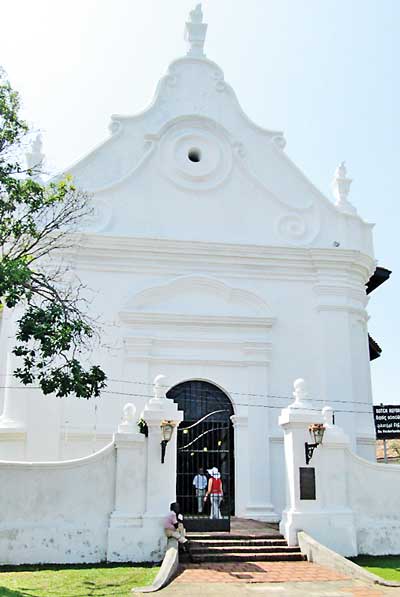Tuesday Nov 18, 2025
Tuesday Nov 18, 2025
Saturday, 24 June 2017 00:32 - - {{hitsCtrl.values.hits}}
By D.C. Ranatunga
Galle Fort is facing the threat of being removed from the list of World Heritage Sites. UNESCO’s warning for two sites in Sri Lanka – Galle Fort and Dambulla Rock Temple – on the grounds of deteriorating conditions was publicly announced by the Education Minister recently. 
As it often happens, the blame is passed on to the previous administration, while stressing that urgent measures are being taken to improve the conditions and conserve them.
It was not so long ago that the deteriorating conditions of the Dambulla Rock Temple was highlighted in Daily FT.
Explaining why Galle was selected as a Heritage Site, UNESCO points out that Galle Fort is “an outstanding example of an urban ensemble, which illustrates the interaction of European architecture and South Asian traditions from the 16th to the 19th centuries”. UNESCO has identified the use of European models adapted by local manpower to the geological, climatic, historical, and cultural conditions of Sri Lanka as the most salient feature.
Although we have got used to talking about the glory of Galle in relation mainly to the period that the Dutch occupied Galle in the latter part of the 17th century through the 18th century, Galle has a history dating back to ancient times.
Galle formed part of the kingdom of Rohana (Ruhuna). Rajarata, Rohana-desa and Malaya-desa formed the ‘Trisinhala-rajaya’ or ‘Tun-rajaya’. They were the three principalities or main territorial territories of the country. Rohana comprised all the area east of the Mahaveli Ganga together with the Batticaloa, Hambantota, Matara and Galle Districts. The capital was Mahagama (Tissamaharama).
At different times Rohana was ruled by princes who were independent or semi-independent of the Anuradhapura king who ruled over Raja-rata. Historical records show that revolts and uprisings originated there and it was always the stronghold of freedom and resistance when foreign rulers invaded or conquered the island.
The best story of a prince from Ruhuna restoring the sovereignty of the country is that of Dutthagamani, who ruled for 24 years (161-137 B.C) after defeating the Tamil ruler Elara, thereby preventing the possibility of the country passing permanently into the hands of the Tamils. Dutthagamani was a descendent of Uparaja Mahanaga, a younger brother of Devanampiyatissa.
There is also reference to a nature reserve close to Galle harbour in the Ramayana, the Hindu epic. The place referred to is Roomassalakanda associated with trees and plants having miraculous healing powers. It is said that this magical herb was used to heal Rama, who was wounded by his brother Lakshman.
Greek records show that Galle was an important trade centre as early as the 4th century AC. King Solomon is said to have sent his merchant ships to ‘Kalach’, which is believed to have been an ancient name for Galle.
Ibn Batuta, the Arabian traveller and navigator, had visited Galle in 1344 AC by which time Galle had been an international harbour. He refers to Galle as ‘Qali’ meaning a ‘bullock station’. Another derivation of Galle is from the Sinhala word ‘gaala’ – place where bullock carts were parked. The cats were the main mode of transport in that era to carry goods about and certain places were set apart for them to take a break.
Culavamsa, the Sri Lankan chronicle, refers to Gimahattita (Gintota), a port at the mouth of Gin Gnaga. The 14th and 15th century ‘sandesa’ poems where birds were sent to take messages from one place to another, also refer to this city.
European on the scene
By the 14th century Galle had established itself as the island’s chief port of call when traders from several parts of the world came in vessels with merchandise. Sri Lanka offered spices which was in great demand in Europe.
In 1505 the accidental landing by the Portuguese in Galle who were on their way to the Maldives to intercept Moorish ships carrying spices was the turning point in Sri Lanka being subject to European invasions. The Portuguese soon moved to Colombo from Galle and stabilised themselves.
It was only after King Rajasinghe I of Sitawaka attacked them that they moved back to Galle and established a stronghold there. That was in 1589. A fort with three bastions was built and it was named Santa Cruz. It was meant to protect possible invasions by foreign powers as well as attacks by the King of Sitawaka.
It was the Dutch who built the present 90-acre fort in 1663 after driving away the Portuguese. They combined the Portuguese northern wall in a great rampart, the most talked-about landmark in Galle. A taller wall was built inside of the ramparts. Between the two walls a covered passage connected the central bastion with the fort’s two half-bastions overlooking the sea. A sophisticated drainage system was installed with brick-lined underground sewers that were flushed by the tides.
The ramparts have become a very popular spot to walk and relax. When a match is being played in the adjoining grounds, it provides a fine view.
There are a number of heritage buildings inside the Fort, most of which had been built by the Dutch. ‘Handbook for the Ceylon Traveller’ – the Studio Times publication discusses the streets and buildings in Galle Fort in several pages. Some of the main buildings are summed up below.
The ‘Groote Kerk’ (Great Church), the oldest Protestant church in Sri Lanka dates back to 1640. Originally built on the site of a Portuguese Capuchin convent, the present church has been completed in 1755. The old, beautiful black and white marble tablets on the walls add an antiquarian touch to the building.
The Government House, the residence of the Commander had been built in 1683 by Thomas Van Rhee. A noteworthy relic of the past are the old, sooty Dutch brick ovens inside. The building had been known as Queen’s House during British times.
The Great Warehouse built in 1669 to store spices and ship equipment today houses the National Maritime Museum and is fully worth a visit.
The single-storey Dutch building, generally considered as the oldest remaining Dutch building built in 1656, is today used as the National Museum, Galle. It had been used to house the commissariat store for the Dutch garrison at the fort.
The solidly-built spacious buildings display the typical Dutch architecture with deep verandahs supported by slender wooden or big rounded brick pillars. The narrow street roads had one been lined with ‘suriya’ trees to stimulate one’s memory. They are no more today.
In recent years most of the properties inside the fort have been purchased by expatriates.
Addressing the media about the unsatisfactory conditions of the UNESO-named two Heritage Sites, the Minister said that the biggest issue is unlawful settlements in these places. He did not, however, mention those responsible for these.